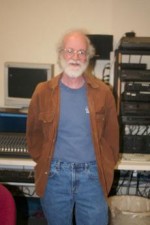Black and white photography lives on at Castleton

As “Photography I” student Kim Dickenson drops her photo paper into the first developer, she slowly sees the emergence of a figure as the paper turns from a foggy gray to a crisp black and white contrast.The satisfaction lights up her face.
“I feel free. I get to manipulate the photo to how I like it,” she said.
Photographers are having a tougher time finding traditional camera supplies in the digital age and black and white photos are even harder to come by. Bu the art department at Castleton State College isn’t willing to let go of the old way of developing just yet.
The college still offers a “Photography I” class that specializes in teaching the fine art of real photography. All you need is an open mind, a 35mm camera, some black and white film and some photography paper.
Black and white pictures show expression and emotion and come to life in the developing process – something you can’t see with a digital camera. They come to life through the gentle slow process of gently sifting a piece of paper through chemicals.
Dona Ann McAdams, an accomplished photographer who teaches the course, enthusiastically directs her students with vivid description and always-moving hands.
To every class she brings she brings books to draw inspiration from. She stresses that each artist has a different image that he or she likes to bring forth.
“You are able to look at detail and spend some time looking at the photos – and sometimes they aren’t looked at, but that’s OK,” she said.
Amanda Barrett, the teaching assistant for last semester’s class, said she enjoys the experience of practical teaching and helping mentor students.
“I definitely want to continue photography as my main profession,” she said. “And I want to mentor students, young and old alike.
She excitedly talked about her love of taking pictures and developing them herself.
“I feel two separate types of emotion,” Barrett said. “When photographing I feel a challenge and I enter my own little world. My camera is an extension of myself. When I’m in the darkroom, I feel anxiousness, a sense of discovery. The magic of the image appearing on the paper.”
Others in class, like Claire Benjamin and Colleen Pruss, were photographers before they even took the class.
“I started when I was about 10 taking pictures with a manual and have been in a darkroom for years,” said Pruss, who has a knack for making pictures appear lifelike. “I like the ability to manipulate and change something. Also, the fact that you can make something out of nothing, it’s magic. I love it, It makes me feel as though I’m in control of everything,” said Pruss.
But it’s not all magic.
Benjamin explained that sometimes old-school photography can be very frustrating.
It’s a challenge. I’ve had really bad luck with my camera and photos, but things are looking up now. I like it and I’m excited,” she said.
Each student artist couldn’t say enough about the “magic” they all felt while developing film, and many expressed sadness at the advent of the digital age.
“Digital has its place, yet I feel as though the regular darkroom and chemicals should stay. You don’t get the same feeling printing out a picture as you do watching it come to life in the developer,” Pruss said.
Dickinson agreed.
“I hate digital. Digital is too perfect, where you can delete the bad pictures. But that’s what photography is all about, capturing the moment,” she said. “Old photography is fun. You never know what you will develop.”
The students say they realize technology isn’t going away, but they hope neither will the ability to print pictures the old-fashioned way.
“Technology is necessary. Digital provides affordable means for the average Joe to make a family portrait,” said McAdams, the class instructor. “But once I can’t use film and paper, I’m done.





